Volkswagen has launched the new Golf R, to bring to seven the new Golf derivatives including Golf GTI.

As the flagship of the range, the the new Golf R is powered by a newly designed 206kW engine, which is 18kW more powerful but up to 18% more fuel-efficient than the sixth generation Golf R.
Like all previous Golf R models, the new model also transfers its turbocharged engine power to the road via a permanent all-wheel drive system. In this case, it is the latest version of the 4Motion system with a fifth-generation Haldex coupling.
Given that the Golf R is going to set you back over R525 000 you would expect a high degree of performance and comfort from a hatchback.
It certainly delivers both aspects, although whether it delivers to that price point is a that will be settled by buyers emotions.
Power it certainly has and the delivery is smooth, but not too quiet, with the 380Nm available across a wide range.
The body height lowered by
20mm which helps to keep the car flat and stable, particularly when fitted with the ptional Dynamic Chassis Control (DCC) system with the driving profile selector that features a new Race mode. There is also a new progressive steering system and “ESC Sport” which delays the point at which the nanny kicks in. No matter what you do she cannot be dismissed entirely.
The Golf R with a manual gearbox (only available in the second half of 2014) reaches 100km/h after just 5.2 seconds (previous mo-del: 5.7 seconds). The classic sprint is completed in five seconds with dual clutch gearbox (DSG). The car’s top speed is electronically limited to 250km/h.
Fuel consumption of the new Golf R is down from 8.5l/100km to 6.9l/100km compared to that of the previous model, bearing in mind these numbers are all so hypothetical as to be meaningless in and of themselves. The new Golf R that is equipped with BlueMotion Technology that offers stop-start system and battery regeneration.
The new Golf R is distinguished at the top of the Golf range by specially designed bumpers, side sills and 19-inch Cadiz alloy wheels, the Golf R can also be visually distinguished by details such as standard bi-xenon headlights with newly designed LED daytime running lights (in dual-U design), dark red LED rear lights and two-branch exhaust system with four chrome tailpipes.
Inside, the Golf R underlines its position as the flagship of the model range with leather sport seats, leather-trimmed three-spoke sport steering wheel, ambience lighting, automatic climate control and a radio-CD system with touchscreen if chosen.
Permanent 4Motion all-wheel drive has always been a trait of the Golf R. Although it brings with it extra weight, the added traction means that getting the increased power down quickly is no problem. The launch units were all fitted with the automatic shifting 6-speed dual-clutch gearbox (DSG). When operating under a relatively low load or when coasting, forward propulsion comes primarily from the front axle, and the rear axle is decoupled. This basic drive layout saves fuel. However, the rear axle of the Golf R can be variably engaged in fractions of a second whenever necessary. This is done via a Haldex
coupling, which is activated by an electro-hydraulic oil pump.
A control unit continually calculates the ideal drive torque for the rear axle and controls how much the multi-plate clutch should be closed by activating the oil pump. The oil pressure increases the contact pressure at the clutch plates in proportion to the torque desired at the rear axle. So, the amount of pressure applied to the clutch plates can be used to vary continuously the magnitude of the transmitted torque. The wheels of the 206kW Golf R are prevented from spinning even when driving off and accelerating, because the control unit regulates the torque distribution as a function of dynamic axle loads. If necessary, nearly 100 per cent of the drive torque can be directed to the rear axle.
In addition to the Haldex coupling that acts as a longitudinal lock, four electronic differential locks (EDS) integrated in the electronic stability control system act as transverse locks. The system briefly brakes a wheel that is slipping, enabling uninterrupted and stable transfer of drive power to the wheel on the opposite side. In the Golf R, the electronic differential locks are implemented at both axles in four-wheel EDS.
In technical terms, XDS+ is a functional extension of the electronic differential locks. When the car is being driven fast, as soon as the electronics detect excessively light loads on wheels on the inside of a bend, the hydraulics of Electronic Stability Control (ESC) apply brake pressure to this wheel to restore optimal traction. XDS+ thereby operates as a transverse differential lock that compensates for understeer during fast cornering.
The new Golf R is offered with a range of standard and optional innovative driver assistance and convenience systems. The assistance and convenience systems in the new Golf R include the standard Automatic Multi-Collision Braking System, progressive steering, an advanced XDS+ electronic differential lock, fatigue detection system, Light Assist, Dynamic Chassis control with driving profile selector, electronic parking brake, Kessy keyless entry and Discover Pro Navigation system.
The new Golf R comes standard with a five-year/90 000km service plan, three-year/120 000km warranty and a 12-year anti-corrosion warranty. Service interval is 15 000km. Pricing for 2.0 TSI 206kW DSG starts at R486 200.
Download our app





